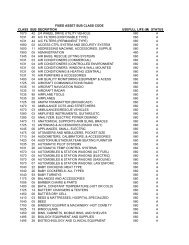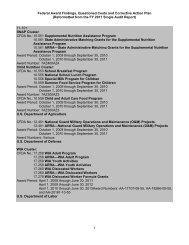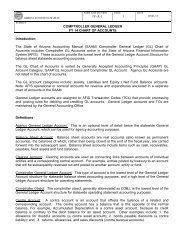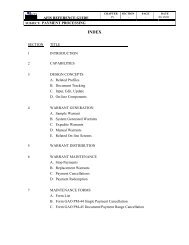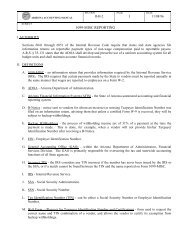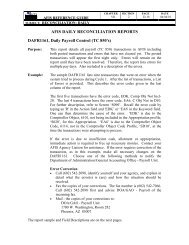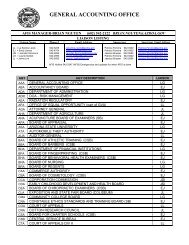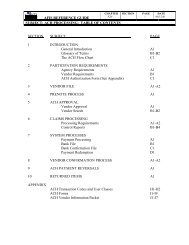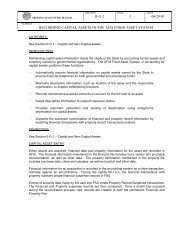GAO Technical Bulletin 07-1 - General Accounting Office
GAO Technical Bulletin 07-1 - General Accounting Office
GAO Technical Bulletin 07-1 - General Accounting Office
Create successful ePaper yourself
Turn your PDF publications into a flip-book with our unique Google optimized e-Paper software.
Subject:<br />
No. <strong>07</strong>-1<br />
<strong>GAO</strong> <strong>Technical</strong> <strong>Bulletin</strong><br />
Arizona Department of Administration <strong>General</strong> <strong>Accounting</strong> <strong>Office</strong><br />
Employee Uniforms<br />
Policy and Procedure Guidelines<br />
Issued: 01/01/<strong>07</strong><br />
Manual Section: N/A Effective: 01/01/<strong>07</strong><br />
Supersedes: <strong>Technical</strong> <strong>Bulletin</strong> 99-8 Page: 1 of 6<br />
TO: <strong>Technical</strong> <strong>Bulletin</strong> Administrators FROM: D. Clark Partridge<br />
All Agencies<br />
State Comptroller<br />
AUTHORITY<br />
26USC162<br />
Trade or business expenses<br />
26CFR1.62-2 Reimbursements and other expense allowance arrangements<br />
A.R.S. § 41-761 Personnel administration<br />
A.R.S. § 41-783 Personnel rules<br />
A.A.C. R-2-5-303.A.2 Salary Administration<br />
Internal Revenue Regulation 31.3401(a)-1(b)(5)<br />
Revenue Rulings 57-143, 70-474, 70-475, 70-476, 72-110, 80-322 et al.<br />
Internal Revenue Service Letter Ruling 8120036<br />
DEFINITIONS<br />
Allowable uniform expenses: Expenses incurred for articles of, insignia affixed to, or the care of<br />
clothing such as shirts, pants, shoes, hats, jackets, coats, and belts required for the performance of<br />
duties as an employee of the State of Arizona, that cannot be adaptable for general use.<br />
HR: Human Resources.<br />
HRIS: Human Resource Information Solution. The statewide HR, benefits, and payroll system<br />
implemented on December 29, 2003.<br />
Pay Code: A code identified in the HRIS to designate the type of earnings an employee will be<br />
paid for, such as regular pay, overtime pay, sick pay, holiday pay, etc.<br />
Uniform allowance: An advance payment to employees for allowable uniform expenses.
<strong>GAO</strong> <strong>Technical</strong> <strong>Bulletin</strong> No. <strong>07</strong>-1<br />
Subject: Employee Uniforms Issued: 01/01/<strong>07</strong><br />
Policy and Procedure Guidelines<br />
Manual Section: N/A Effective: 01/01/<strong>07</strong><br />
Supersedes: <strong>Technical</strong> <strong>Bulletin</strong> 99-8 Page: 2 of 6<br />
INTRODUCTION<br />
Agency Heads are empowered to perform those acts necessary to pursue the goals of their<br />
agencies and to expend such monies necessary to accomplish their agencies’ missions. The<br />
appropriateness of such expenditures is determined by the Legislature. When, however, such<br />
expenditures involve monies disbursed to or for the benefit of personnel, they are subject to<br />
Federal and State laws that govern the characterization, legality and taxability of those<br />
expenditures.<br />
Compensation paid to employees of the State of Arizona is governed by the Arizona Revised<br />
Statutes and the Arizona Administrative Code. Unless otherwise specifically provided, such<br />
compensation is treated like wages or salaries and subject to FICA and Medicare taxes as well as<br />
federal and state withholding.<br />
The following Policies have been prepared and should be used to assist agency management<br />
when considering the implementation of an employee uniform policy.<br />
POLICY<br />
1) When an employer provides uniforms or pays uniform allowances, Federal tax laws, rulings<br />
and regulations stipulate and court decisions uphold that, in order to be considered<br />
non-taxable to the employee, the following conditions must be met:<br />
a) the uniforms must be required by the employer;<br />
b) the uniforms cannot be adaptable for general use.<br />
i) the cost of uniforms that are determined to be adaptable for general use will be<br />
considered taxable wages to the employee;<br />
c) the uniform allowances must qualify as ordinary and necessary business expenses; and<br />
d) payments made to employees are provided under an accountable plan.<br />
i) In order to be considered as reimbursed under an accountable plan, the expense must<br />
meet three requirements: (1) there must be a business connection to the expense; (2)<br />
there must be adequate substantiation for the expense; and (3) excess reimbursement<br />
amounts must be returned to the employer within a reasonable period of time.<br />
2) Uniforms are to be provided only under the terms of a policy and procedure document,<br />
published by the adopting agency. Policy and procedure documents must specify:
<strong>GAO</strong> <strong>Technical</strong> <strong>Bulletin</strong> No. <strong>07</strong>-1<br />
Subject: Employee Uniforms Issued: 01/01/<strong>07</strong><br />
Policy and Procedure Guidelines<br />
Manual Section: N/A Effective: 01/01/<strong>07</strong><br />
Supersedes: <strong>Technical</strong> <strong>Bulletin</strong> 99-8 Page: 3 of 6<br />
a. that wearing the prescribed uniform, under those circumstances outlined by the<br />
policy, is mandatory;<br />
b. the characteristics, designs and styles of the uniform or uniforms to be adopted;<br />
c. that, except in the case of protective gear or in the case of trade or profession specific<br />
clothing, a badge or other distinctive insignia is to be worn as part of or in<br />
conjunction with the uniform and that such badge or insignia must clearly identify<br />
the wearer as an employee of the State of Arizona;<br />
d. those employees, by category, who are required to wear such uniforms;<br />
e. those circumstances under which employees are required to wear uniforms;<br />
f. that wearing a uniform is prohibited except when the employee is on duty or<br />
commuting to or from the work site;<br />
g. the method in which the uniforms are to be provided (monthly allowance, uniform<br />
rental, reimbursement of expenses, etc.);<br />
h. the way in which the uniform policy is to be amended; and<br />
i. an approved list of vendors for uniforms and accessories, when an allowance is paid<br />
for the purchase and care of uniforms or the agency purchases the uniforms directly.<br />
3) State agencies electing to either furnish uniforms, pay employees a uniform allowance or<br />
reimburse State employees for uniform expenses must determine which of the following<br />
methods will govern their internal policies and procedures:<br />
a) The agency may establish a uniform allowance that requires no substantiation. The<br />
uniform allowance must be input and paid through the HRIS as taxable compensation to<br />
the employee using Pay Code 601.<br />
b) The agency may purchase and pay for the uniforms and care of the uniforms directly<br />
through a State contracted vendor.<br />
c) The agency may reimburse employees for allowable uniform expenses after receiving<br />
receipts for such expenses from the employee.<br />
d) The agency may establish a uniform allowance with an accountable plan.
<strong>GAO</strong> <strong>Technical</strong> <strong>Bulletin</strong> No. <strong>07</strong>-1<br />
Subject: Employee Uniforms Issued: 01/01/<strong>07</strong><br />
Policy and Procedure Guidelines<br />
Manual Section: N/A Effective: 01/01/<strong>07</strong><br />
Supersedes: <strong>Technical</strong> <strong>Bulletin</strong> 99-8 Page: 4 of 6<br />
i) In order to meet the requirements for substantiation, if the agency elects to establish<br />
an accountable plan, all employees receiving a uniform allowance must substantiate<br />
allowable uniform expenses by submitting receipts to his or her agency or by<br />
submitting an agency developed uniform allowance substantiation form. An agency<br />
developed form must be submitted to the <strong>GAO</strong> for review and approval prior to<br />
implementation.<br />
(1) The employee must submit substantiation to his or her agency within sixty (60)<br />
days following the end of the quarter in which the uniform allowance payment<br />
occurred.<br />
(2) Amounts paid to the employee in excess of substantiated allowable uniform<br />
expenses must be returned to the agency within ninety (90) days following the<br />
end of the quarter in which the uniform allowance payment occurred. Amounts<br />
paid to the employee in excess of substantiated allowable uniform expenses that<br />
are not returned to the agency within this ninety (90) day period will be subject<br />
to tax withholding in the HRIS in the subsequent pay period.<br />
(3) Agency developed uniform allowance substantiation forms must the include all<br />
dates, amounts and descriptions of allowable uniform expenses incurred that will<br />
allow the agency to identify the specific nature of the expense and to conclude<br />
that the expense is attributable to the agency’s statutory mission.<br />
ii) If the agency establishes an accountable plan, it may establish a uniform allowance to<br />
be paid through HRIS as non-taxable compensation to the employee using a<br />
non-taxable Pay Code. Agencies may contact the <strong>GAO</strong> for a list of non-taxable<br />
uniform allowance Pay Codes in HRIS.<br />
iii) An agency electing to establish an accountable plan for uniforms must outline the<br />
specific criteria of this plan in its policy and procedure document, which must be<br />
submitted to the <strong>GAO</strong> for review and approval prior to implementation.<br />
iv) An agency’s accountable plan is subject to periodic audit and review by the <strong>GAO</strong>.<br />
Any audit findings of non-compliance with the policies and procedures as established<br />
in this technical bulletin will result in an immediate conversion from an accountable<br />
plan to the recording of those payments in the HRIS as taxable compensation to the<br />
employee.<br />
4) Uniforms should be furnished only under those circumstances in which the benefits far<br />
outweigh the costs of providing uniforms. Such circumstances include, but may not be<br />
limited to:
<strong>GAO</strong> <strong>Technical</strong> <strong>Bulletin</strong> No. <strong>07</strong>-1<br />
Subject: Employee Uniforms Issued: 01/01/<strong>07</strong><br />
Policy and Procedure Guidelines<br />
Manual Section: N/A Effective: 01/01/<strong>07</strong><br />
Supersedes: <strong>Technical</strong> <strong>Bulletin</strong> 99-8 Page: 5 of 6<br />
a. fostering public safety: when the employee must be readily identifiable to the public<br />
as a figure of authority or when the employee’s duties require frequent access to private<br />
property in an official capacity;<br />
b. maintaining employee safety: where the uniform provides a degree of protection not<br />
afforded by street wear (i.e. overalls, smocks, safety boots, goggles, etc.);<br />
c. preventing employee hardship: where the nature of the job soils or destroys clothing<br />
considerably faster or to a much greater extent than is occasioned by normal wear and<br />
tear; and<br />
d. adhering to professional or trade practices: where certain types of dress conform to<br />
the expectations of society.<br />
5. Except when there are clear and compelling circumstances to the contrary, uniforms should<br />
only be provided to those employees whose duties put them in frequent, regular and repetitive<br />
contact with the public and the nature of that contact requires the exercise of authority by the<br />
State employee.<br />
6. Uniforms should not be considered for any combination of the following reasons alone:<br />
a. to enhance employee or organizational morale or esprit de corps;<br />
b. to augment an employee’s compensation; or<br />
c. to substitute for a normal, common sense dress code or the enforcement of such a<br />
code.<br />
7. Uniform colors and styles should not be:<br />
a. radical in design or of a style likely to reflect poorly on the State;<br />
b. misleading as to the nature of the job;<br />
c. suitable for use as street wear; or,<br />
d. easily confused with uniforms used for other purposes.<br />
8. Expenditures for uniforms or uniform allowances shall not be made when such expenditures<br />
would, under Federal or State income tax or employment laws, result in additional<br />
compensation to the employees with respect to whom such expenditures would be made.
<strong>GAO</strong> <strong>Technical</strong> <strong>Bulletin</strong> No. <strong>07</strong>-1<br />
Subject: Employee Uniforms Issued: 01/01/<strong>07</strong><br />
Policy and Procedure Guidelines<br />
Manual Section: N/A Effective: 01/01/<strong>07</strong><br />
Supersedes: <strong>Technical</strong> <strong>Bulletin</strong> 99-8 Page: 6 of 6<br />
9. The provision of specialized wearing apparel for infrequent or special circumstances is not<br />
prohibited by these policies.<br />
ON-LINE AVAILABILITY<br />
Copies of this and other <strong>Technical</strong> <strong>Bulletin</strong>s, including supplemental documents when feasible<br />
and appropriate, are available for viewing and downloading from the <strong>Technical</strong> <strong>Bulletin</strong> Page of<br />
the <strong>General</strong> <strong>Accounting</strong> <strong>Office</strong> Website located at:<br />
http://www.gao.state.az.us/publications/tb/bulletins.html<br />
AREAS IMPACTED<br />
All State agencies.<br />
CONTACTS<br />
If you have any questions regarding this <strong>Technical</strong> <strong>Bulletin</strong>, please contact your <strong>GAO</strong> Liaison.<br />
You may also e-mail questions or comments concerning State policy and procedure to us at:<br />
gaopolicy@azdoa.gov



